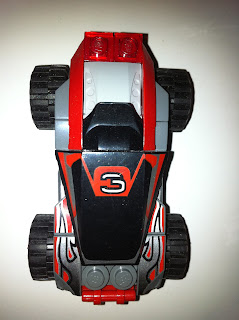Character
Spencer, the robotic arm thinks to himself: Oh man, I got to do the same work everyday, I am getting sick and tired of my work. I want to try the other work that the other robots are doing for a change. Why am I stacking all these boxes for anyway? Its not like we don't have not enough space! I am so angry right now I just want to smash all these boxes right now! Grrrrr.....
Storyboard
The drawing shown above is the storyboard that I have done.
4.)The fourth drawing depicts Spencer as if regretting his actions, stopping to look around to check if anyone saw his rebellious act. Spencer seems to be regretting his actions before.
5.) The fifth drawing depicts Spencer stricken with guilt, as he stacks the boxes back again.
Self-Critique
I plan to implement the 'Timing' principle into my animation when Spencer smashes the tower of boxes and the boxes will fly in the air and land as if gravity is acting on the boxes. This will help make my animation more realistic and believable. The 'Follow through and overlapping action' principle will also be implemented into my animation. As Spencer lifts up the boxes, it will not be an easy task due to the heavy weight of the boxes. Hence, as Spencer lifts the boxes his body may arc a little and the initial lifting of the box will be a little slower as the box lifts off the ground, to show that Spencer is not used to the heavy weight of the boxes.
1.) The first drawing depicts Spencer getting his work done as per normal, but something seems peculiar about his working attitude today. It seems exceptionally slow and reluctant.
2.) The second drawing depicts Spencer getting bored of his work and stopping to think to himself. Spencer is looking at the tower of boxes that he have stacked and thinking to himself if it was really worth his time all this while.
3.) The third drawing depicts Spencer suddenly throwing a tantrum and he vents his anger on his work. Spencer smashes the tower of boxes with anger, causing the boxes to fly in different directions.
4.)The fourth drawing depicts Spencer as if regretting his actions, stopping to look around to check if anyone saw his rebellious act. Spencer seems to be regretting his actions before.
5.) The fifth drawing depicts Spencer stricken with guilt, as he stacks the boxes back again.
Self-Critique
I plan to implement the 'Timing' principle into my animation when Spencer smashes the tower of boxes and the boxes will fly in the air and land as if gravity is acting on the boxes. This will help make my animation more realistic and believable. The 'Follow through and overlapping action' principle will also be implemented into my animation. As Spencer lifts up the boxes, it will not be an easy task due to the heavy weight of the boxes. Hence, as Spencer lifts the boxes his body may arc a little and the initial lifting of the box will be a little slower as the box lifts off the ground, to show that Spencer is not used to the heavy weight of the boxes.






















































